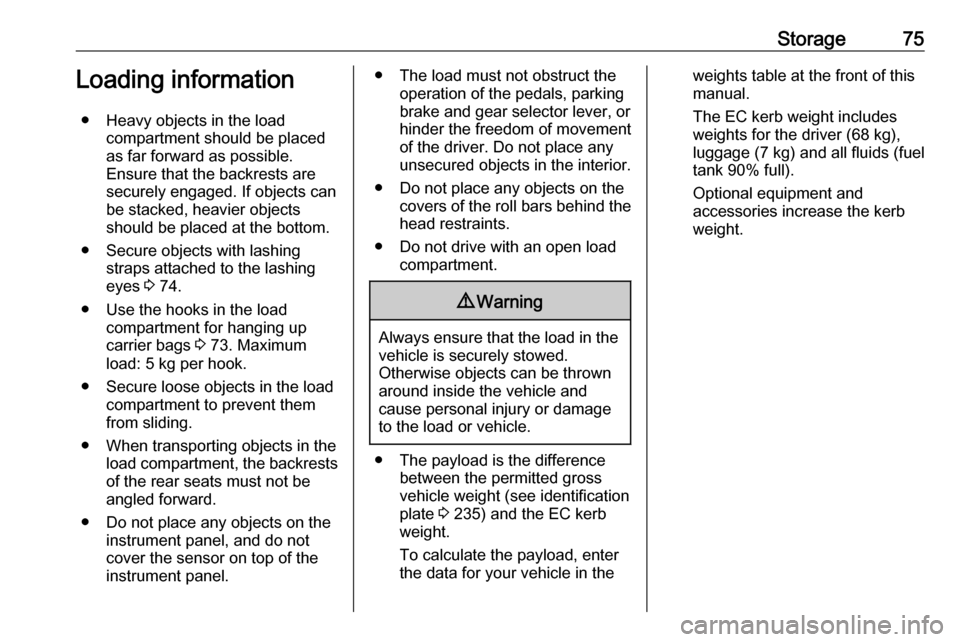weight VAUXHALL CASCADA 2018 Owner's Manual
[x] Cancel search | Manufacturer: VAUXHALL, Model Year: 2018, Model line: CASCADA, Model: VAUXHALL CASCADA 2018Pages: 265, PDF Size: 7.81 MB
Page 67 of 265

Seats, restraints65Child restraint installation locations
Permissible options for fitting a child restraint system
Weight class
On front passenger seat
On rear seats
activated airbagdeactivated airbagGroup 0: up to 10 kgXU 1UGroup 0+: up to 13 kgXU 1UGroup I: 9 to 18 kgXU1U2Group II: 15 to 25 kgXXUGroup III: 22 to 36 kgXXU1:If the child restraint system is being secured using a three-point seat belt, move seat into the rear adjustment area
and set seat height to uppermost position. Adjust seat backrest as far as necessary to a vertical position to ensure
that the belt is tight on the buckle side.2:Remove rear head restraint when using child restraint systems in this weight group 3 45.U:Universal suitability in conjunction with three-point seat belt.X:No child restraint system permitted in this weight class.
Page 68 of 265

66Seats, restraintsPermissible options for fitting an ISOFIX child restraint systemWeight classSize classFixtureOn front passenger seatOn rear seatsGroup 0: up to 10 kgEISO/R1XIL *Group 0+: up to 13 kgEISO/R1XIL *DISO/R2XIL *CISO/R3XIL *Group I: 9 to 18 kgDISO/R2XIL *CISO/R3XIL *BISO/F2XIL, IUF**B1ISO/F2XXIL, IUF**AISO/F3XIL, IUF**Group II: 15 to 25 kgXILGroup III: 22 to 36 kgXILIL:Suitable for particular ISOFIX restraint systems of the 'specific-vehicle', 'restricted' or 'semi-universal' categories.The ISOFIX restraint system must be approved for the specific vehicle type.IUF:Suitable for ISOFIX forward-facing child restraint systems of universal category approved for use in this weight class.X:No ISOFIX child restraint system approved in this weight class.*:Move the respective front seat ahead of the child restraint system forwards as far as necessary.**:Remove respective rear head restraint when using child restraint systems in this size class 3 45.
Page 69 of 265

Seats, restraints67ISOFIX size class and seat deviceA – ISO/F3:Forward-facing child restraint system for children of maximum size in the weight class 9 to 18 kg.B – ISO/F2:Forward-facing child restraint system for smaller children in the weight class 9 to 18 kg.B1 – ISO/F2X:Forward-facing child restraint system for smaller children in the weight class 9 to 18 kg.C – ISO/R3:Rear-facing child restraint system for children of maximum size in the weight class up to 18 kg.D – ISO/R2:Rear-facing child restraint system for smaller children in the weight class up to 18 kg.E – ISO/R1:Rear-facing child restraint system for young children in the weight class up to 13 kg.
Page 77 of 265

Storage75Loading information● Heavy objects in the load compartment should be placed
as far forward as possible.
Ensure that the backrests are
securely engaged. If objects can
be stacked, heavier objects
should be placed at the bottom.
● Secure objects with lashing straps attached to the lashing
eyes 3 74.
● Use the hooks in the load compartment for hanging up
carrier bags 3 73. Maximum
load: 5 kg per hook.
● Secure loose objects in the load compartment to prevent themfrom sliding.
● When transporting objects in the load compartment, the backrestsof the rear seats must not be
angled forward.
● Do not place any objects on the instrument panel, and do not
cover the sensor on top of the
instrument panel.● The load must not obstruct the operation of the pedals, parking
brake and gear selector lever, or
hinder the freedom of movement of the driver. Do not place any
unsecured objects in the interior.
● Do not place any objects on the covers of the roll bars behind the
head restraints.
● Do not drive with an open load compartment.9Warning
Always ensure that the load in the
vehicle is securely stowed.
Otherwise objects can be thrown
around inside the vehicle and
cause personal injury or damage
to the load or vehicle.
● The payload is the difference between the permitted grossvehicle weight (see identification
plate 3 235) and the EC kerb
weight.
To calculate the payload, enter the data for your vehicle in the
weights table at the front of this
manual.
The EC kerb weight includes
weights for the driver (68 kg),
luggage (7 kg) and all fluids (fuel
tank 90% full).
Optional equipment and
accessories increase the kerb
weight.
Page 182 of 265

180Driving and operatingIn case of an emergency, refill with a
canister. A funnel must be used to
open the cap of the filler neck.
The funnel is located in the load
compartment.
Place the funnel in a straight line to
the filler neck and press with slight
force to insert.
Use the funnel to fill the diesel fuel into the filler neck.
After topping-up, put the funnel into
the plastic bag and stow it in the
storage compartment.
Selective catalytic reduction system
3 141.
Fuel filler cap
Only use genuine fuel filler caps. Diesel-engined vehicles have special fuel filler caps.
Fuel consumption - CO 2-
Emissions The fuel consumption (combined) is
within a range of 39 to 54 mpg.
The CO 2 emission (combined) is
within a range of 172 to 138 g/km.
For the values specific to your
vehicle, refer to the EEC Certificate of
Conformity provided with your vehicle or other national registration
documents.
General information The official fuel consumption and
specific CO 2 emission figures quoted
relate to the EU base model with
standard equipment.
Fuel consumption data and CO 2
emission data are determined
according to regulation
R (EC) No. 715/2007 (in the latestapplicable version), taking into
consideration the vehicle weight in
running order, as specified by the
regulation.
The figures are provided only for the purpose of comparison between different vehicle variants and mustnot be taken as a guarantee for the
actual fuel consumption of a
particular vehicle. Additional
equipment may result in slightly
higher results than the stated
consumption and CO 2 figures.
Furthermore, fuel consumption is dependent on personal driving style
as well as road and traffic conditions.
Page 183 of 265

Driving and operating181Trailer hitch
General information
Only use towing equipment that has
been approved for your vehicle.
Entrust retrofitting of towing
equipment to a workshop. It may be
necessary to make changes that
affect the cooling system, heat
shields or other equipment.
The bulb outage detection function for trailer brake light cannot detect a
partial bulb outage, e.g. in case of 4 x
5 Watt bulbs, the function only detects
lamp outage when only a single
5 Watt lamp remains or none remain.
Fitting of towing equipment could
cover the opening of the towing eye.
If this is the case use the coupling ball bar for towing. Always keep the
coupling ball bar in the vehicle.Driving characteristics and
towing tips
Before attaching a trailer, lubricate the coupling ball. However, do not do
so if a stabiliser, which acts on the coupling ball, is being used to reduce snaking movements.
For trailers with low driving stability
and caravan trailers with a permitted
gross vehicle weight of more than
1200 kg the use of a stabiliser is
strongly recommended when driving
above 50 mph.
If the trailer starts snaking, drive more slowly, do not attempt to correct the
steering and brake sharply if
necessary.
When driving downhill, drive in the
same gear as if driving uphill and
drive at a similar speed.
Adjust tyre pressure to the value
specified for full load 3 246.Trailer towing
Trailer loads The permissible trailer loads are
vehicle and engine-dependent
maximum values which must not be
exceeded. The actual trailer load is the difference between the actual
gross weight of the trailer and the
actual coupling socket load with the
trailer coupled.
The permissible trailer loads are
specified in the vehicle documents. In general, they are valid for gradients
up to max. 12%.
The permitted trailer load applies up to the specified incline and up to an
altitude of 1000 metres above sea
level. Since engine power decreases
as altitude increases due to the air
becoming thinner, therefore reducing
climbing ability, the permissible gross
train weight also decreases by 10%
for every 1000 metres of additional
altitude. The gross train weight does
not have to be reduced when driving
on roads with slight inclines (less than
8%, e.g. motorways).
Page 184 of 265

182Driving and operatingThe permissible gross train weight
must not be exceeded. This weight is
specified on the identification plate
3 235.
Vertical coupling load The vertical coupling load is the load
exerted by the trailer on the coupling
ball. It can be varied by changing the
weight distribution when loading the
trailer.
The maximum permissible vertical
coupling load (75 kg) is specified on
the towing equipment identification
plate and in the vehicle documents.
Always aim for the maximum load,
especially in the case of heavy
trailers. The vertical coupling load
should never fall below 25 kg.Rear axle load
When the trailer is coupled and the
towing vehicle fully loaded, the
permissible rear axle load (see
identification plate or vehicle
documents) may be exceeded by 100 kg, the gross vehicle weight
rating may be exceeded by 100 kg. If
the permissible rear axle load is
exceeded, a maximum speed of
60 mph applies.
Towing equipmentCaution
When operating without a trailer,
remove the coupling ball bar.
Stowage of coupling ball bar
The coupling ball bar is stowed in a
bag and must be secured in the load
compartment.
Vehicle with spare wheel
The bag with the coupling ball bar is
placed near the spare wheel under
the load floor cover.
Direct the strap through the rim and around the wheel, wrap it around the
coupling ball bar and tighten the strap
to secure the bag.
Page 211 of 265

Vehicle care209Wheels and tyres
Wheels
On vehicles with Diesel engines, no
steel rims and only special, vehicle-
approved alloy wheels are permitted.
Tyre condition, wheel condition Drive over edges slowly and at right
angles if possible. Driving over sharp
edges can cause tyre and wheel
damage. Do not trap tyres on the kerb when parking.
Regularly check the wheels for
damage. Seek the assistance of a
workshop in the event of damage or
unusual wear.
Winter tyres
Winter tyres improve driving safety at temperatures below 7 °C and should
therefore be fitted on all wheels.
All tyre sizes are permitted as winter
tyres 3 246.
Use tyre size 245/45 R18 only as winter tyres.On vehicles with Diesel engines, no
steel rims and only special, vehicle-
approved alloy wheels are permitted.
In accordance with country-specific
regulations, affix the speed sticker in
the driver's field of view.
Tyre designations E.g. 235/55 R 17 99 V235:Tyre width, mm55:Cross-section ratio (tyre height
to tyre width), %R:Belt type: RadialRF:Type: RunFlat17:Wheel diameter, inches99:Load index e.g. 99 is
equivalent to 775 kgV:Speed code letter
Speed code letter:
Q:up to 100 mphS:up to 112 mphT:up to 118 mphH:up to 130 mphV:up to 150 mphW:up to 168 mph
Choose a tyre appropriate for the
maximum speed of your vehicle.
The maximum speed is achievable at
kerb weight with driver (75 kg) plus
125 kg payload. Optional equipment
could reduce the maximum speed of
the vehicle.
Performance 3 241.
Directional tyres Fit directional tyres such that they roll
in the direction of travel. The rolling
direction is indicated by a symbol
(e.g. an arrow) on the sidewall.
Tyre pressure monitoringsystem
The tyre pressure monitoring system
checks the pressure of all four tyres
once a minute when vehicle speed
exceeds a certain limit.Caution
Tyre pressure monitoring system
warns only about low tyre pressure condition and does not replace
regular tyre maintenance by the
driver.
Page 237 of 265

Technical data235Technical dataVehicle identification..................235
Vehicle Identification Number ..235
Identification plate ...................235
Engine identification ................236
Vehicle data ............................... 237
Recommended fluids and lubricants ................................ 237
Engine data ............................. 240
Performance ............................ 241
Vehicle weight ......................... 243
Vehicle dimensions .................244
Capacities ................................ 245
Tyre pressures ........................ 246Vehicle identification
Vehicle IdentificationNumber
The Vehicle Identification Number
may be stamped on the identification plate and on the floor pan, under thefloor covering, visible under a cover.
The Vehicle Identification Number
may be embossed on the instrument
panel, visible through the windscreen,
or in the engine compartment on the
right body panel.
Identification plate
The identification plate is located on
the front left or right door frame.
Page 238 of 265

236Technical dataInformation on identification label:1:Manufacturer2:Operating permit number3:Vehicle Identification Number4:Permissible gross vehicle weight
rating in kg5:Permissible gross train weight
in kg6:Maximum permissible front axle
load in kg7:Maximum permissible rear axle
load in kg8:Vehicle-specific or country-
specific data
The combined total of front and rear
axle loads must not exceed the
permissible gross vehicle weight. For
example, if the front axle is bearing its
maximum permissible load, the rear
axle can only bear a load that is equal
to the gross vehicle weight minus the front axle load.
The technical data is determined in
accordance with European
Community standards. We reserve
the right to make modifications.
Specifications in the vehicle
documents always have priority over
those given in this manual.
Engine identification
The technical data tables show the
engine identifier code. Engine data
3 240.
To identify the respective engine,
refer to the engine power in the EEC
Certificate of Conformity provided
with your vehicle or other national
registration documents.